With the recent galactic impact which occurred in Siberia still fresh in the minds of most, the unfathomably supersonic power of these rarely interfered with projectiles seems a fitting subject for a Top 10 list. Widely believed as the cause of the close of the Jurassic age, asteroid impacts pose a threat both constant and serious to the inhabitants of Earth, or for that matter any planet. Sheer momentum gives even the smallest of asteroids a force capable of extinguishing civilizations in an instant. Aside from the damage enacted on the planet’s surface at the moment of impact, asteroids can cause a whole host of separate issues in the nearby atmosphere, making them a very real, very dangerous menace indeed. To put the recent impact in central Russia into a little more perspective, the asteroid was considered by experts as ‘minimal’ in size and density, yet caused reverberations which seriously injured over 1,000 people, not to mention smashed every window within a 100 mile radius. With this, not only can we be thankful for the projectiles comparative small size, but for the fact that its visit signifies likelihood of a moderate length of time before we are gifted with another. Here are some of the most notable Asteroid Impact Sites which scar our oh so vulnerable planet’s surface currently.
10. Chesapeake Bay

Making its way through the Galaxy to collide with the Eastern Shore of the North American continent some 35 million years ago, the asteroid which landed at Chesapeake Bay in the Eocene Epoch created a long lasting scar on the surrounding landscape. Smashing into the same coastline which is now home to Western Virginia, the moderately sized bolide responsible for the impact vaporized almost instantly as a result of the immense speed at which it was travelling. Back then, the geography of the impact area was far different than it is today, with soft tropical rain-forest as opposed to sturdy continental shelf resulting in a crater that is not only over 30 kilometers wide, but also astonishingly deep.
9. Kara-Kul Lake

One of the most recently discovered impact sites of its kind on the planet, Kara-Kul sits majestically 13,000 feet above sea-level in the Pamir mountains, which border Tajikistan with China. At 25 kilometers wide, the lake is the result of a moderately powerful meteorite impact which is estimated to have taken place some 5 million years ago. As its location is so desolate, the lake itself has only been widely known about for a few decades. On top of this, the nature of its creation was only determined several years ago via satellite imagery technology. With a maximum depth measurement of 750ft, the lake is living evidence of the power to change entire landscapes held by meteors and asteroids.
8. Barringer Crater

Located in Northern Arizona, the Barringer Crater is named after the Pennsylvanian mining engineer who first claimed the cause for the craters existence. Believed to be around 50,000 years old, the Barringer crater is an example of an exposed crater and was first come across by European New World settlers in the 19th century. Originally thought to be the result of volcanic activity, a fair assessment given the locality of the San Francisco Volcanic fields, Daniel Barringer’s theory was initially met with little hospitality. Widely considered to be the most well preserved impact site of its kind on the planet, the Barringer crater is around 4,000ft in diameter and 570ft deep.
7. Deep Bay

Dating from the Cretaceous Period, Deep Bay is the result of a particularly huge meteorite impact. Located in the South Western corner of Reindeer Lake in Northern Saskatchewan, Canada, Deep Bay was first discovered as a result of its irregular depth in an otherwise moderate lake. At 220m deep, the crater is the deepest body of water in Saskatchewan, and also one of the widest at 13km. Given the size and characteristics of the impact crater, as well as the fact that it managed to completely overhaul the geography of an already large open water body, the projectile which caused it undoubtedly caused chaos in the surrounding atmosphere.
6. Manacouagan Crater

The Manicouagan Crater lies in the North Western part of Canada, Quebec to be precise. With an estimated age of between 213 and 215 million years, it is one of the oldest known craters of its kind on the planet. Situated 300km to the North of the city of Baie-Comeau, the Manicouagan Crater is not just one of the oldest, but one of the largest astroblemes on our planet. Measuring in at 100km across, the crater is believed to have been caused by an asteroid no smaller than 5 kilometers in diameter. Associated for a considerable amount of time by many as the site of impact of the asteroid which wiped out the dinosaurs, the Manicouagan Crater is the subject of widespread study to this day.
5. Gosses Bluff
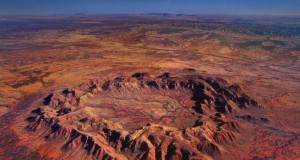
Situated in almost the dead-centre of the Australian continent, Gosses Bluff crater lies some 100 miles from Alice Springs in the East and 130 miles from Uluru in the South West. Believed to be the result of an asteroid or comet impact which occurred sometime during the late Jurassic/early Cretaceous boundary, time has slowly but surely ensured the craters camouflage within its surroundings. Only considered as being the result of an intergalactic impact from the 1960’s onwards, Gosses Bluffs size has shrunk from an estimated 22km to a mere 5km in the millions of years since its creation. An exposed crater, the site holds much cultural significance with the Australian people, particularly the native Aborigines, who know it as ‘Tnorala’.
4. Chicxulub Crater
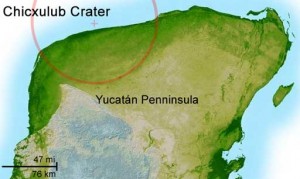
Buried under the Yucatan Peninsula in Central Mexico, the Chicxulub crater is a Prehistoric asteroid impact site over 180kilometres in diameter. Estimated to have been infinitely carved into the landscape 65 million years ago by a bolide around six miles wide, the force with which the crater was created is believed to have been the equivalent of 100 teratons of TNT. When the asteroid hit, a mega-tsunamis of unfathomable size would have engulfed every coastline within several thousand miles, a thick layer of superheated ash and dust would have filled the environment for a period of months if not years, and a series of coordinated volcanic eruptions and earthquakes would have caused surface chaos all over the planet. No wonder this impact is widely attributed to bringing about the end of the Dinosaurs.
3. Mistastin Lake
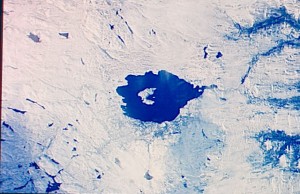
With a diameter of around 16kilometers, the crater which acts to host Mistastin Lake is far from being the largest impact site of its kind; however is an intriguing area of our planet nonetheless. Dating from the ‘Eocene’ epoch (56-34 million years ago), the original size of the crater is believed to be a more substantial 28km, however time, and indeed geography has taken its toll. Located in the most Western Canadian province of Newfoundland, Mistastin Lake boasts a picturesque quality, enhanced more-so by the addition of ‘Horseshoe Island’ in the centre.
2. Lake Bosumtwi
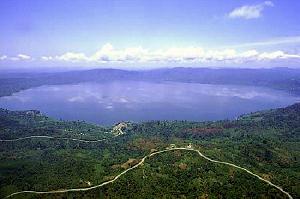
Yet another site which has transformed into a Lake during the time since impact, Lake Bosumtwi, or rather the impact crater in which it sits, was created just over one million years ago. At 8.6 kilometres wide and 265ft deep, the crater is far from being one of the largest, however is undoubtedly one of the more important impact craters on Earth; culturally and geographically speaking. Situated in Southern Ghana, the Lake is surrounded on all sides by thick, difficult and uncompromising rainforest. Whilst this fact poses serious problems for the geologists and surveyors seeking to learn more about the Lakes history, the state of preservation serves to drastically enhance the existence of the thousands of neighbouring tribes people, to whom it is a vital source of water, not to mention an extremely important spiritual landmark.
1. Aorounga Crater
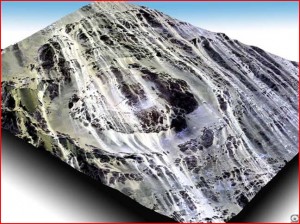
Another of the many prominent asteroid impact craters which scar the African continent, the Aorounga Impact Crater is situated in Chad. The crater is exposed and measures at 12.6km in diameter, with an estimated age of some 345 million years. Given the sheer age of the blemish, as well as the geography of the land surrounding it, there is still a lot to be learned about it. One theory relating to the crater however, is that it belongs to a larger chain which extends in a Northward direction. Through the use of satellite imaging, many experts see some truth in this, referring to the Aorounga Crater as ‘Aorounga South’.
http://en.wikipedia.org/wiki/List_of_impact_craters_on_Earth
http://geology.com/meteor-impact-craters.shtml
http://www.environmentalgraffiti.com/featured/10-greatest-major-impact-craters-on-earth/1403